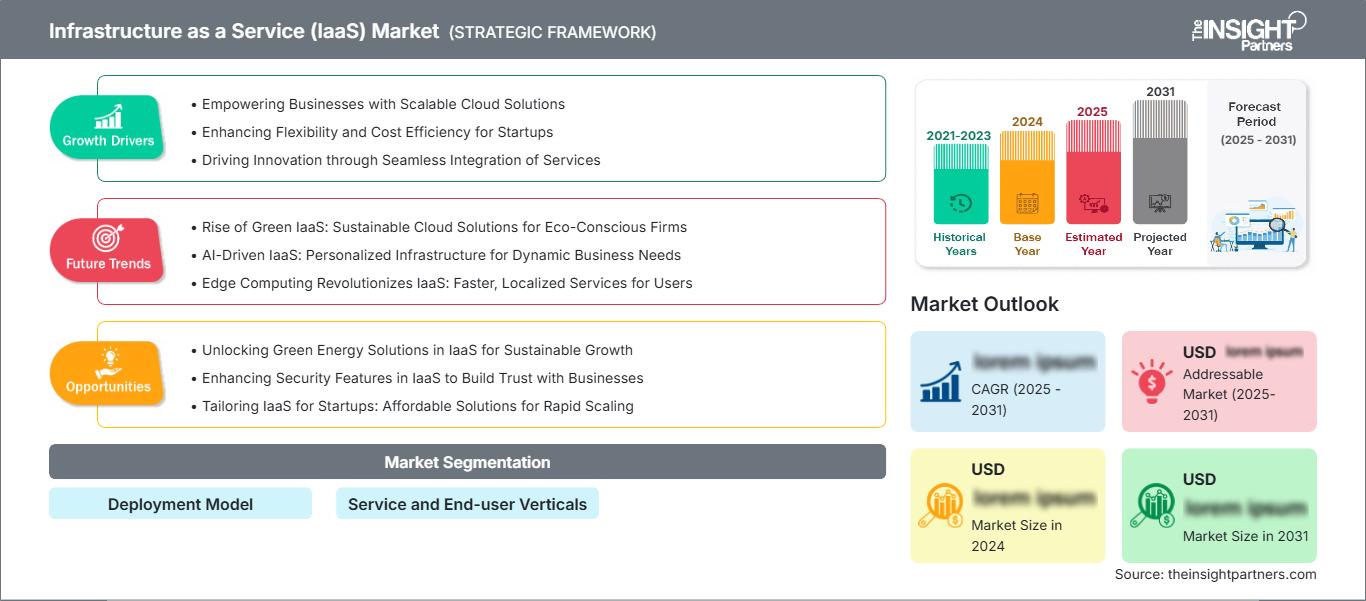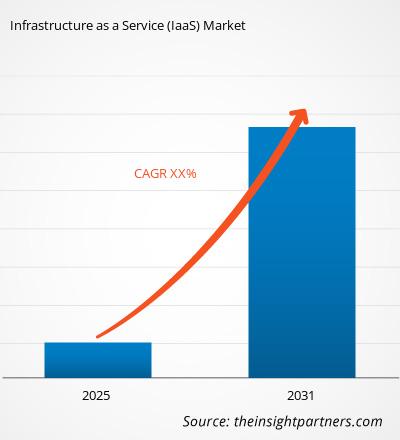Si prevede che il mercato dell'Infrastructure as a Service (IaaS) raggiungerà i 772,59 miliardi di dollari entro il 2031. Si prevede che il mercato registrerà un CAGR del 20,7% nel periodo 2025-2031.
Il rapporto è suddiviso in base al modello di distribuzione e analizza ulteriormente il mercato in base ai settori verticali dei servizi e degli utenti finali. Per ciascuno di questi segmenti chiave viene fornita una ripartizione completa a livello globale, regionale e nazionale. Il rapporto include le dimensioni del mercato e le previsioni per tutti i segmenti, presentando i valori in dollari statunitensi. Fornisce inoltre statistiche chiave sullo stato attuale del mercato dei principali attori, insieme ad approfondimenti sulle tendenze di mercato prevalenti e sulle opportunità emergenti.
Scopo del rapporto
Il rapporto sul mercato dell'Infrastructure as a Service (IaaS) di The Insight Partners mira a descrivere il panorama attuale e la crescita futura, i principali fattori trainanti, le sfide e le opportunità. Ciò fornirà approfondimenti a vari stakeholder aziendali, come:
- Fornitori/produttori di tecnologia: per comprendere le dinamiche di mercato in evoluzione e conoscere le potenziali opportunità di crescita, consentendo loro di prendere decisioni strategiche informate.
- Investitori: per condurre un'analisi completa delle tendenze in merito al tasso di crescita del mercato, alle proiezioni finanziarie del mercato e alle opportunità esistenti lungo la catena del valore.
- Organismi di regolamentazione: per regolamentare le politiche e le attività di polizia nel mercato con l'obiettivo di ridurre al minimo gli abusi, preservare la fiducia degli investitori e sostenere l'integrità e la stabilità del mercato.
Modello di distribuzione della segmentazione del mercato dell'infrastruttura come servizio (IaaS)
Settori verticali di servizi e utenti finali
Potrai personalizzare gratuitamente qualsiasi rapporto, comprese parti di questo rapporto, o analisi a livello di paese, pacchetto dati Excel, oltre a usufruire di grandi offerte e sconti per start-up e università
Mercato dell'infrastruttura come servizio (IaaS): Approfondimenti strategici

-
Ottieni le principali tendenze chiave del mercato di questo rapporto.Questo campione GRATUITO includerà l'analisi dei dati, che vanno dalle tendenze di mercato alle stime e alle previsioni.
Fattori di crescita del mercato dell'infrastruttura come servizio (IaaS)
- Fornire alle aziende soluzioni cloud scalabili
- Migliorare la flessibilità e l'efficienza dei costi per le startup
- Promuovere l'innovazione attraverso l'integrazione perfetta dei servizi
Tendenze future del mercato dell'infrastruttura come servizio (IaaS)
- Ascesa dell'IaaS verde: soluzioni cloud sostenibili per aziende eco-consapevoli
- IaaS basato sull'intelligenza artificiale: infrastruttura personalizzata per esigenze aziendali dinamiche
- L'edge computing rivoluziona l'IaaS: servizi più veloci e localizzati per gli utenti
Opportunità di mercato dell'infrastruttura come servizio (IaaS)
- Sbloccare soluzioni di energia verde in IaaS per una crescita sostenibile
- Migliorare le funzionalità di sicurezza in IaaS per creare fiducia con le aziende
- Adattare IaaS alle startup: soluzioni convenienti per una rapida scalabilità
Mercato dell'infrastruttura come servizio (IaaS)
Le tendenze regionali e i fattori che influenzano il mercato dell'Infrastructure as a Service (IaaS) durante il periodo di previsione sono stati ampiamente spiegati dagli analisti di The Insight Partners. Questa sezione illustra anche i segmenti di mercato e la geografia della gestione delle malattie del ritmo cardiaco in Nord America, Europa, Asia-Pacifico, Medio Oriente e Africa, America meridionale e centrale.
Ambito del rapporto di mercato sull'infrastruttura come servizio (IaaS)
| Attributo del rapporto | Dettagli |
|---|---|
| Dimensioni del mercato in 2024 | US$ XX Billion |
| Dimensioni del mercato per 2031 | US$ 772.59 Billion |
| CAGR globale (2025 - 2031) | 20.7% |
| Dati storici | 2021-2023 |
| Periodo di previsione | 2025-2031 |
| Segmenti coperti | By Modello di distribuzioneBy Servizi e settori verticali dell'utente finale |
| Regioni e paesi coperti |
Nord America
|
| Leader di mercato e profili aziendali chiave |
|
Densità degli attori del mercato dell'infrastruttura come servizio (IaaS): comprendere il suo impatto sulle dinamiche aziendali
Il mercato dell'Infrastructure as a Service (IaaS) è in rapida crescita, trainato dalla crescente domanda degli utenti finali, dovuta a fattori quali l'evoluzione delle preferenze dei consumatori, i progressi tecnologici e una maggiore consapevolezza dei vantaggi del prodotto. Con l'aumento della domanda, le aziende stanno ampliando la propria offerta, innovando per soddisfare le esigenze dei consumatori e sfruttando le tendenze emergenti, alimentando ulteriormente la crescita del mercato.

- Ottieni il Mercato dell'infrastruttura come servizio (IaaS) Panoramica dei principali attori chiave
Punti di forza
- Copertura completa: il rapporto analizza in modo esaustivo prodotti, servizi, tipologie e utenti finali del mercato dell'infrastruttura come servizio (IaaS), offrendo una panoramica olistica.
- Analisi degli esperti: il rapporto è redatto sulla base della conoscenza approfondita di esperti e analisti del settore.
- Informazioni aggiornate: il rapporto garantisce la pertinenza aziendale grazie alla copertura di informazioni e tendenze dei dati più recenti.
- Opzioni di personalizzazione: questo rapporto può essere personalizzato per soddisfare le esigenze specifiche del cliente e adattarsi in modo appropriato alle strategie aziendali.
Il rapporto di ricerca sul mercato dell'infrastruttura come servizio (IaaS) può quindi contribuire a guidare il percorso di decodificazione e comprensione dello scenario del settore e delle prospettive di crescita. Sebbene possano esserci alcune valide preoccupazioni, i vantaggi complessivi di questo rapporto tendono a superare gli svantaggi.
- Analisi storica (2 anni), anno base, previsione (7 anni) con CAGR
- Analisi PEST e SWOT
- Valore/volume delle dimensioni del mercato - Globale, Regionale, Nazionale
- Industria e panorama competitivo
- Set di dati Excel
Report recenti
Testimonianze
Motivo dell'acquisto
- Processo decisionale informato
- Comprensione delle dinamiche di mercato
- Analisi competitiva
- Analisi dei clienti
- Previsioni di mercato
- Mitigazione del rischio
- Pianificazione strategica
- Giustificazione degli investimenti
- Identificazione dei mercati emergenti
- Miglioramento delle strategie di marketing
- Aumento dell'efficienza operativa
- Allineamento alle tendenze normative






















 Ottieni un campione gratuito per - Mercato dell'infrastruttura come servizio (IaaS)
Ottieni un campione gratuito per - Mercato dell'infrastruttura come servizio (IaaS)